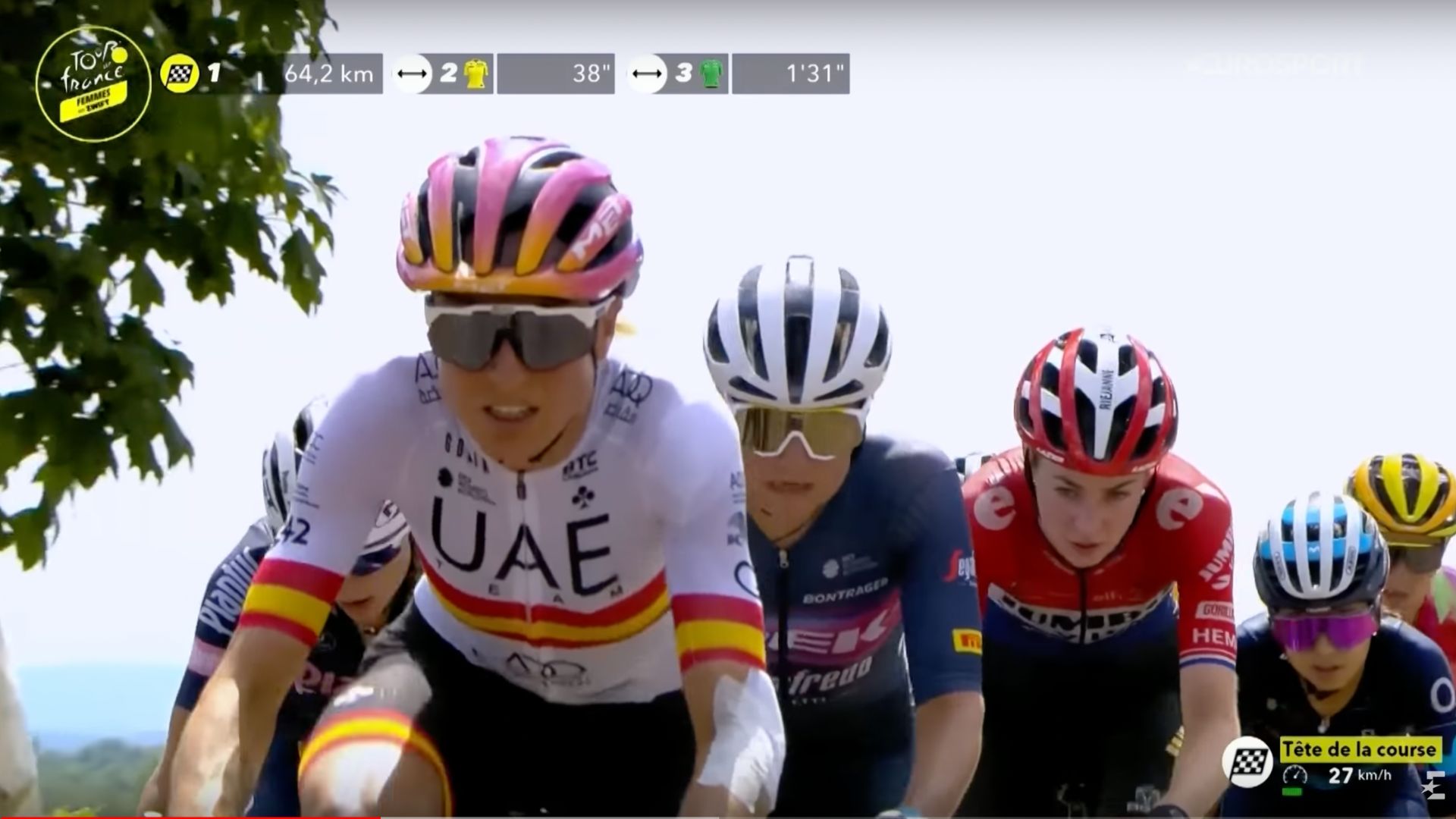they were 144 to leave for 8 days of racing. The Tour de France Women and its 1033 kilometers ended on July 30, with the victory of Dutchman Annemiek van Vleuten.
Absent for a long time, it has met with great success both for its presence on the side of the roads to encourage runners, and in front of the small screen: France Télévisions can boast an impressive and unexpected audience, with 2.1 million spectators on average in the afternoon and a total of 19.8 million French who saw this first edition.
What to hope for the other editions? How to explain this success that gives hope to runners, but also to all women’s sport? Some answers with Marion Philippe, sports historian and specialist in the place of women in sport.

The long absence from the Tour de France
A return ofa competition we haven’t seen on the streets since 1989.
“There have been women’s races in France since 1989 that have tried to counter this discontinuation of the Tour de France brand. The sauce did not take and therefore there were economic difficulties “explains to Marion Philippe Lose.
A common argument when it comes to limiting the presence of women in sports competitions: “A bit like Coubertin in 1912 who had used, among other things, economic arguments to justify the impossibility of offering Games for women. “
Since the 1990s, therefore, we have seen several similar races, the organizers of which have not been able to use the “Tour de France” brand: the CEE women’s tourthen the big ring until 2009. Between 2014 and 2021, the relay is taken over by The Le Tour de France race, which is then held during the men’s Tour de France. It is therefore difficult to capture the media attention already monopolized by the event.
Only this year, therefore, the Tour de France Women has made its official comeback.
Big disparities between the men’s and women’s tours
On many levels, the women’s Tour de France does not have the resources of the men’s Tour. A reflection of the disparities between men and women in cycling :
“Yes, there is a distinction in the fact that the Tour de France Women were few to be professionals while in the Men Tour de France, all the men were professionals”emphasizes Marion Philippe. “Then there is a fairly significant difference in treatment in terms of economic gains at the end of the different races. ”
Female participants, like their male counterparts, receive bonuses. While the 176 male riders of the 2022 Tour de France shared € 2.3 million in a 23-day race over 21 stages, the women had to decide among themselves… € 274,530.
“In the Tour de France, the participation bonuses and the victory bonus for the winner are 10 times less important than in the men’s Tour de France”confirms Marion Philippe.
“The more plausible explanation may be that the women’s Tour de France has fewer sponsors than the men’s Tour de France. However, I think that the media success and the mass of spectators on the roadside will allow in a short time the arrival of various sponsors that will allow the athletes’ prizes to be increased. At least I hope.
In various other competitions, the prize has seen a gradual increase over the years, so I hope it’s the same for the women’s Tour de France. “
A not-so-surprising craze
For Marion Philippe, the media and popular growth of this first edition of the Tour de France Women is not so surprising and is part of a global evolution around women’s sportto which the public seems increasingly fond of, and its media coverage:
“I think the Tour de France Women benefits from the general enthusiasm for the Tour de France brand, which has been a truly popular event for more than a century, but also from the media coverage of women’s sport.
On the streets, there seems to have been a lot of people, and when we look at the France Télévisions audience, we can be just as pleased as there were over 19 million viewers on the entire tour and the latest event brought together more than 3 million viewers. This is clearly not ridiculous in the face of the so-called men’s Tour de France. “
In the wake of the Tour de France Women, it is also Euro 2022 which, while not equaling the spectator record of the 2019 Women’s World Cup in France, was nevertheless widely followed, particularly with 7 million people in front of their screens to watch France’s semi-final. against Germany. Proof of the fact that the performances of women’s sports are increasingly followed:
“We see more and more women’s sports and women dare, if we can say so, to look at women’s sports, but also men and without necessarily being all critical”says Marion Philippe.
A success not spared by sexism
A video from Brut recently showed the treatment of multiple world champion cyclist Jeannie Longo in front of male cyclists, including Marc Madiot, now head of the Groupama-FDJ team.
It would be tempting to see a sequence from a bygone era in it. However, this is far from true.

“Marc Madiot’s words have been resonating on social media for a few days, but this is a global thought”Marion Philippe is keen to clarify.
“There is no point in blaming a man when thousands of others feel the same way right now. Of course, this hasn’t helped the affairs of female cyclists who have long suffered from cycling stereotypes at first and then cycling later. “
On the 28th July stage linking Bar-le-Duc to Saint-Dié-des-Vosges, a collective crash created a pile of bicycles across the street. A pile-up as we often see in cycling races. Except here, it’s the women who hold the dumbbell and inevitably, the jokes about the wheels, or the alleged danger of driving women, went well.
Nothing really surprising, comments Marion Philippe: “These are things you eventually get used to seeing when you work on women’s sports and watch social media. Women’s football, widely publicized at the same time as the Tour de France, suffered the same earthquakes. “
Sexist remarks and oh so subversive and stinging (no), even from by a former sports journalist like Pierre Salviacwondering if “Women are ready for this level of competition. “
The cyclists themselves were eager to respond to these misogynistic attacks:
Wow, men really seem to break down a lot when they ride a bike. Maybe they aren’t ready for this level of competition yet?
🤭😉 #TDFF https://t.co/m7ohbS2Sj7
– Lizzy Banks (@ElizzyBanks) July 31, 2022
“Wow, men seem to have a lot of accidents when they ride bicycles. Maybe they aren’t ready for this level of competition? “
For the haters …
I must continue? pic.twitter.com/4twtPWhbtf– Christine Majerus (@C_Majerus) July 28, 2022
“For the haters… should I continue? “
If the speech of a Marc Madiot sadly remains topical and despite the persistence of this type of comment, there is also an impetus towards women’s sport in general, which goes beyond these sexist clichés:
“The comments are incredibly violent, but they seem to come from people who don’t know much about cycling.”tempera Marion Philippe.
“Accidents are finally part of the sport and demonstrate once again that there is no distinction between what one could call women’s cycling and men’s cycling, but there is cycling practiced by both men and women. “
Despite an unfortunately very predictable sexism, this first edition delighted both sports commentators and the public. It is also Marion Rousse, the director of the Women’s Tour, who talks about it better France blue :
“People have understood that it is a real Tour, no matter if it is for men or women. There are a lot of people at the departures and arrivals, but also all along the route. And to see guys on the side of the road come and encourage the athletes, or people who dress up and make signs as we are used to seeing on the streets in July, is a winning bet. “
See you in 2023?
Photo credit: Eurosport (YouTube acquisition)
Source: Madmoizelle
Lloyd Grunewald is an author at “The Fashion Vibes”. He is a talented writer who focuses on bringing the latest entertainment-related news to his readers. With a deep understanding of the entertainment industry and a passion for writing, Lloyd delivers engaging articles that keep his readers informed and entertained.




